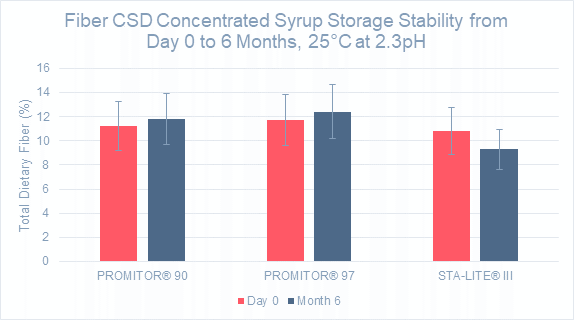How Fiber is Shaping the Functional Beverage Market
By Grace Kim, Technical Service, Beverages, and Rebecca Frapasella, Senior Scientist
The functional beverage market has exploded in recent years, with brands innovating to deliver health benefits. At Tate & Lyle, one ingredient we are especially excited about is fiber. Fiber not only supports digestive health but can also enhance mouthfeel and help the overall experience when we reduce the sugar content in a formulation.
However, fiber stability in acidic environments—such as carbonated soft drinks—is a challenge. A recent proprietary study we conducted sheds light on the stability of certain fiber ingredients in these conditions, providing valuable insights for our beverage partners and us.
Functional beverages: a rapidly evolving category
The term “functional beverages” covers many products, including everything from adaptogenic teas to energy drinks to enhanced water and even some carbonated soft drinks.
The soft drink industry has evolved significantly from early attempts at fortification. Notably, we’ve seen some major cola launches, primarily in the APAC region, with added vitamins and fiber. Today, more brands are leveraging functional ingredients to create “better-for-you” alternatives to traditional sodas, including some exciting new products incorporating prebiotic fiber. Meanwhile, kombucha brands are expanding their portfolios to compete with these emerging prebiotic sodas, highlighting the growing consumer demand for health solutions that fit seamlessly into their existing lifestyles. It’s a dynamic market space, and there is still room for those willing to innovate to capture a larger share of it.
Fiber’s role in sugar reduction and mouthfeel enhancement
While fiber is a common ingredient in functional beverages—and other products—for digestive benefits, it also plays a crucial role in sugar reduction. Removing or reducing sugar in a beverage can result in a thinner mouthfeel, which the consumer may perceive as a lack of richness or body. Even after building back sweetness with one of our sweetening solutions, there remains a noticeable difference in consistency. Fiber can help compensate for this by enhancing texture, thereby making reduced-sugar and no-sugar-added beverages more satisfying by more closely emulating the experience of full-sugar formulations.
Although our study focused specifically on fiber stability rather than sugar reduction, we can use fiber to improve nutrition and taste. Incorporating fiber alongside sweeteners helps us create a balanced, full-bodied beverage.
Understanding fiber stability in low-pH beverages
Carbonated soft drinks pose a challenge when you add fiber—or do anything to change a formulation—because they require concentrated syrup to dilute with carbonated water. That means the ingredients needed for the final product must exist in this compressed state. Soft drink concentrates, as used in bag-in-box systems for quick service restaurants, has an extremely low pH, often as low as 2.25 to 2.3. Maintaining fiber’s stability in this highly acidic environment is crucial.
Our recent study examined the stability of our portfolio of fibers in these concentrated systems over time. Given that syrup concentrates can be stored for up to six months, it was essential to determine whether the fiber content would remain intact. For our tests, we created a concentrated syrup model system with a 2.3 pH. We monitored a variety of formulations using our range of fiber products over a three-month storage period at 77°F.

The findings were exceptional: our PROMITOR® 90 and PROMITOR® 97 soluble corn fibers demonstrated strong stability, retaining virtually all of their fiber content throughout the test period. Our STA-LITE® III polydextrose also performed very well in the test. That puts us in an excellent position to meet a variety of formulation needs for fiber-enhanced carbonated soft drinks.
Advancements in sweetening solutions
As we touched on before, another critical aspect of functional beverage formulation is achieving optimal sweetness without relying on high-calorie sweeteners. In the ingredients solutions business, we have something we colloquially call the “Jellybean Rule.” That means you can put all the vitamins you want into a jellybean, but you still can’t call it healthy because it’s full of sugar. (Which brings to mind our Sugar-Free Nutritional Pectin Gummy prototype.)
Today’s sugar-reduction strategies focus on nuanced approaches that balance a variety of sweeteners. For example, using a blend of stevia and nutritive sweeteners helps achieve a more natural taste while maintaining a lower calorie count.
One exciting development in this space is our Optimizer 8.10, a stevia-based solution we launched last year that delivers a sugar-like taste at a lower cost than other choices. Additionally, the industry is shifting toward diversified stevia sourcing, with emerging supply chains providing new possibilities for manufacturers. Tate & Lyle now offers an All-Americas Reb M stevia—it’s exciting to think we can readily access stevia grown in Peru and finished in the United States for those customers who feel that would best suit their goals.
The importance of digestive tolerance in fiber selection
It isn’t common knowledge that not all fibers are created equal when it comes to how well the digestive system deals with them. Some fibers, such as inulin, can cause digestive discomfort at relatively low intake levels. In contrast, soluble corn fiber and polydextrose have significantly higher tolerances, allowing for greater inclusion rates without adverse effects.
Our fiber ingredients, including PROMITOR® Soluble Corn Fiber and STA-LITE® Polydextrose, can be included in beverages at levels that qualify as an “excellent source of fiber” without causing digestive issues. This factor makes them a highly viable option for manufacturers aiming to enhance fiber content while maintaining a smooth consumer experience. This kind of flexibility and formulation expertise sets us apart at Tate & Lyle and makes us uniquely able to work with our customers to create problem-solving products already in demand.
The future of functional beverages
As the functional beverage market grows, fiber will play an increasingly important role in product development. With our new insights into fiber stability, improved sweetening solutions, and a growing understanding of digestive health, we have more tools than ever to create nutritious and enjoyable beverages. Because at the end of the day, it has to taste amazing to get that repeat purchase.
Consumers today have far more choices, moving beyond traditional diet sodas to a wide array of health-conscious alternatives. Whether through digestive support, sugar reduction, or enhanced mouthfeel, fiber will be a key player in shaping the next generation of beverages. As research continues, we can expect even more innovation in this space as we bridge the gap between health and indulgence in the beverage aisle.
Need some functional beverage inspiration? Visit our Prototype Pantry for the latest developments from our passionate food scientists.

